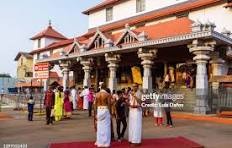– Mohamed Atherulla Shariff
Dharmasthala, the famed temple town nestled in the Western Ghats of coastal Karnataka, is usually spoken of in reverent tones. It is celebrated as a symbol of charity, interfaith harmony, and a place where tradition meets philanthropy. Millions visit the shrine each year, many seeking spiritual solace, others admiring the social service institutions it nurtures.
But in mid-2025, the town was catapulted into an unsettling spotlight. Allegations from a former sanitation worker – allegations of mass killings, sexual violence, and secret burials spanning nearly two decades – have rattled Karnataka’s conscience. What was long whispered in activist circles has now exploded into a full-fledged investigation, reopening painful wounds of unresolved cases and raising disturbing questions about power, complicity, and silence.
A Whistleblower’s Tale
In July 2025, a man who had once worked in Dharmasthala stepped forward with chilling claims. Between 1995 and 2014, he said he was forced to bury or burn hundreds of bodies. Most, he alleged, were women and young girls.
His testimony painted a grotesque picture: corpses showing signs of sexual assault and strangulation, some scarred with acid burns; the bodies of schoolgirls still in uniform; beggars rounded up and never seen again. He identified 13 sites where he said the remains were hidden.
The revelations, dramatic and graphic, spread like wildfire. For many families still awaiting closure for missing loved ones, it was a moment of painful recognition. For others, it seemed almost too horrific to believe.
SIT Probe Begins
The Karnataka government, under intense public pressure, acted quickly. On July 19, 2025, it constituted a Special Investigation Team (SIT) headed by senior IPS officer DGP Pronab Mohanty.
Excavations at the 13 alleged sites yielded mixed results: nine were barren, one revealed a partial skeleton, and another produced a skull with bones. Forensic testing later indicated that some of the remains belonged to men, contradicting the whistleblower’s insistence that they were female victims
The whistleblower’s credibility took a hit when he was arrested for perjury on August 23. Yet, officials have stressed that the investigation is far from over. “Even if some claims are exaggerated or false, they have opened a door into unsolved disappearances that demand scrutiny,” a senior police officer remarked.
The SIT has since expanded its focus, exploring whether these allegations connect to other missing persons cases across Karnataka and neighbouring states.
Old Cases, New Demands
The Dharmasthala storm has stirred memories of past tragedies. Among them is the 2012 murder of Soujanya, a college student whose body was found under mysterious circumstances. Her case, marked by public protests and allegations of cover-ups, remains unresolved in the minds of many. Similarly, the 1986 killing of Padmalatha continues to haunt locals.
Now, families of victims like Soujanya and Padmalatha are demanding that their cases be included in the SIT probe. “For years we were told to move on. Now we know why justice never came,” said a relative of one victim.
Journalists and activists, too, recall their struggles. Publications such as Lankesh Patrike had, for decades, documented suspicions around disappearances in the region. Their work was often ignored, dismissed, or actively suppressed. “We faced ridicule, sometimes even threats, for raising these issues,” says a senior journalist who covered the story in the 1990s. “The whistleblower’s testimony, whatever its flaws, validates that our concerns were not baseless.”
Missing Records, Missing Truth
One revelation that has deepened suspicion is the admission by Belthangady Police that they destroyed 15 years of records on “unidentified deaths” between 2000 and 2015. The timing is crucial – it overlaps almost exactly with the period the whistleblower described.
For many, this act feels less like administrative housekeeping and more like deliberate erasure. “Those files could have provided crucial leads. Without them, families are left clinging to rumours instead of records,” says a human rights activist in Mangaluru.
Legal experts argue that such destruction of records, particularly in a region with a history of unexplained deaths, raises serious accountability questions. “This is not just about one case or one whistleblower. It’s about systemic negligence,” noted a retired High Court judge.
Faith Meets Fear
Dharmasthala is not just another temple town. It is an institution that blends ritual, social service, and philanthropy. The Dharmadhikari family, custodians of the temple for centuries, are revered figures who preside over both spiritual and social life. Their institutions run free educational and health services, drawing praise from across the country.
That makes the allegations all the more unsettling. For devotees, the town represents purity and service. But now, a cloud of suspicion looms. “We came here for peace of mind. Now, all we see in the news is death and fear,” said a pilgrim visiting in August.
The temple authorities have denied any wrongdoing and distanced themselves from the claims. Yet, the fact that allegations of such magnitude are being investigated in a place of worship challenges the very image Dharmasthala has cultivated for decades.
The Struggle for Justice
The Dharmasthala episode highlights a broader pattern in Karnataka: how cases of missing women often fade into silence. Activists point to the intersection of caste, class, and gender that leaves poor women most vulnerable. “When a beggar girl goes missing, who registers a complaint? Who follows it up? These women disappear twice – first physically, then statistically,” says a Bengaluru-based women’s rights campaigner.
The whistleblower’s arrest has complicated the narrative, with some branding him an opportunist. Yet, his testimony has forced a reckoning. “Even if half of what he said is true, it demands answers,” argues an advocate working on women’s rights.
The Road Ahead
For now, the SIT’s work continues. The team has hinted at reopening certain cold cases and may collaborate with forensic experts outside the state. Whether this leads to justice – or simply another cycle of allegations and denials – remains to be seen.
What is certain is that Dharmasthala can no longer return to quiet reverence without addressing the shadows that now surround it. For families of the missing, for journalists who sought the truth, and for a public torn between faith and fear, the town is no longer just a place of worship; it’s the stage for Karnataka’s most disturbing mystery.
As dusk falls on the temple town, the air carries both devotion and doubt. Pilgrims bow before the deity inside, while outside, investigators sift through soil and memory. Between the chants of faith and the silence of the dead lies the question no one can escape: what really happened in Dharmasthala?




